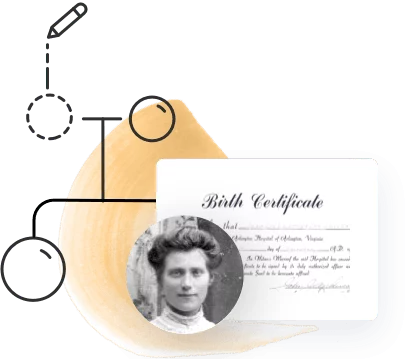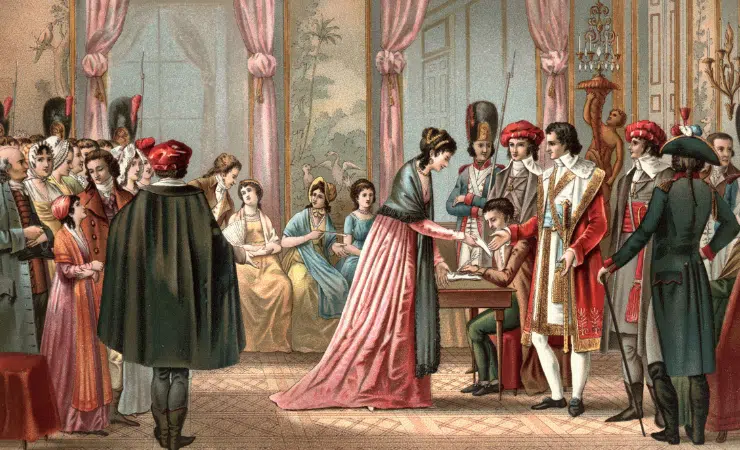
Researching ancestors who hailed from France? You’ve come to the right place. MyHeritage is an absolute treasure trove for French genealogy. The platform offers a vast range of valuable historical records going back to the 17th century and a huge collection of family trees from Filae, one of the foremost genealogy services in France. These resources, alongside extremely useful translation technologies and automatic conversion of French Republican Calendar dates to their Gregorian equivalents, make MyHeritage the best place to research French family history.
Research your French ancestors on MyHeritage
In this article, we’ll cover the basic geographical and historical information you need to know before embarking on your French genealogy journey, and explore a sampling of French historical records to show you how to get the most out of them.
Administrative divisions in France: regions, departments, communes, and more
France has an extremely detailed system of administrative subdivisions. The country is divided into 18 regions, including 13 regions in continental France (known as “metropolitan France”) and 5 regions overseas. The regions are further divided into a total of 96 departments; the departments are further divided into 342 arrondissements; these are divided into 2,054 cantons; and finally, at the most granular administrative level, 36,658 communes or local authorities.
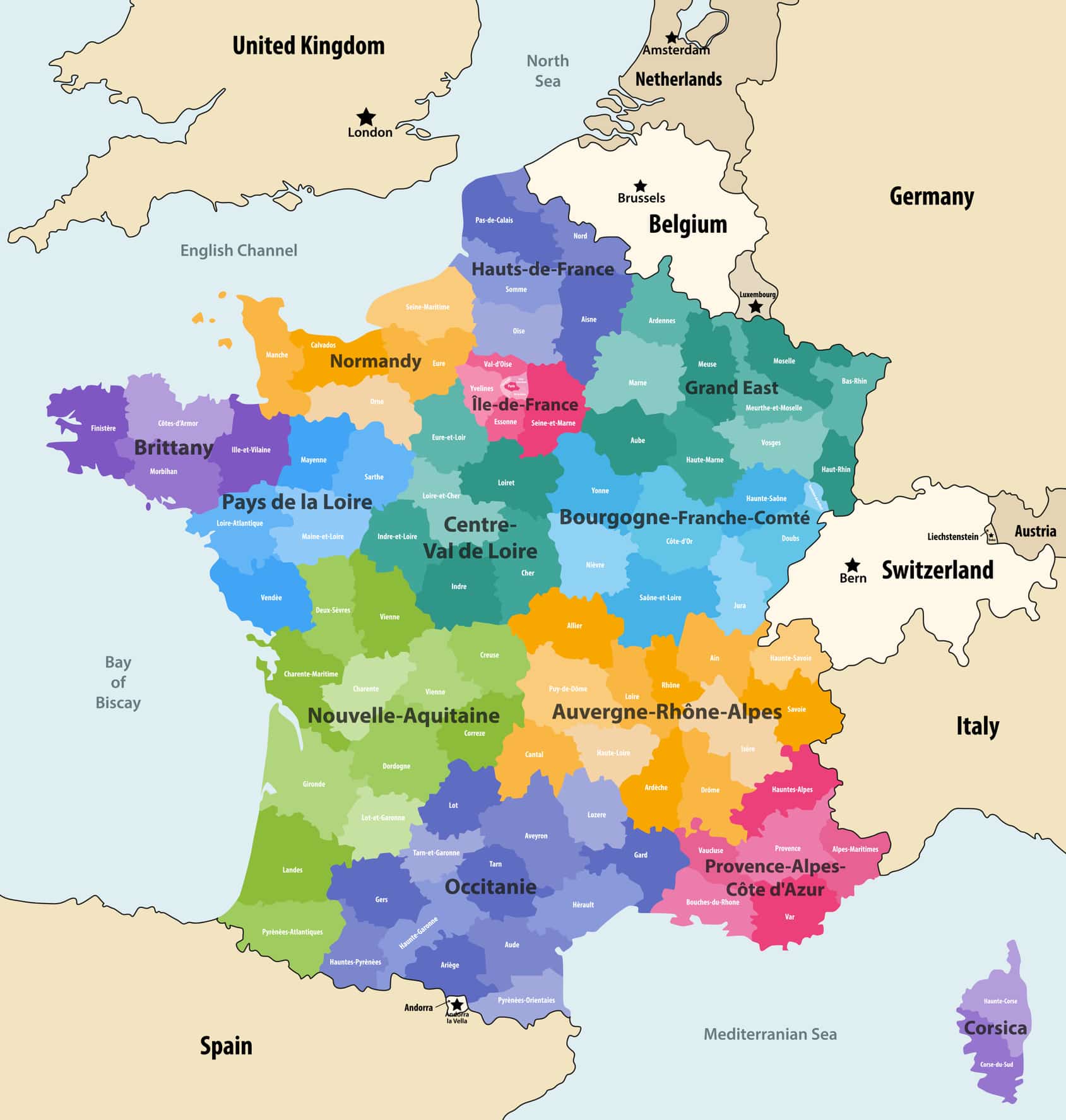
Communes are equivalent to civil townships or incorporated municipalities in the U.S. and Canada, civil parishes in the U.K., Gemeinden in Germany, municipios in Spain and comuni in Italy. They were developed along with departments at the start of the French Revolution as local municipal governments. The sizes of communes can vary greatly depending on various factors.
The arrondissements and cantons are not public or local authorities, so when MyHeritage lists the location of a given record, we generally list 4 levels of jurisdiction: the commune, department, region, and country. We may also list the town or village as the lowest level of jurisdiction, if it is known.
Many of the departments of France have microfilmed and digitized their records, but haven’t indexed them, making them difficult to search. Filae, a French genealogy platform that became part of MyHeritage in 2021, had a major role in indexing these digitized records.
French departments have assigned numbers from 1–96 that are used universally across France and within French records.
Understanding French dates
One factor that may complicate French family history research is the fact that for 14 years, from 1792–1805, the French government used a unique calendar, known as the French Republican Calendar. This calendar was introduced as part of the French Revolution as a more logical, secular alternative to the Gregorian calendar used in the rest of Europe and the United States at the time.
The French Republican Calendar contained 12 months, with each month made up of 3 décades that contained 10 days each instead of 7-day weeks. 5 supplementary days were added at the end of the year (6 during a leap year) to keep the system aligned with the seasons. The calendar started at the autumnal equinox, corresponding to the Gregorian months of September/October, and the months were named after natural seasonal phenomena. You can read more about the French Republican Calendar in the following articles:
- Understanding Historical Dates and Calendars for Genealogical Research by James Tanner
- French Republican Calendar by Dr. David Heffernan from the MyHeritage Wiki
While this unique calendar might have seemed a great idea at the time, it can be a source of much confusion for modern genealogists analyzing historical records from the period. MyHeritage automatically converts Republican dates to their Gregorian counterparts, which can greatly help eliminate that confusion. However, the original French Republican dates will appear in the original scans of the records.
Another source of some difficulty in reviewing the original French records is that dates, including years, were often written out longhand rather than in numerals. For example, the year 1863 would be written as mille huit cent soixante-trois. For this reason, it’s a good idea to learn French numbers, or to have a chart of the numbers written out when you approach an original record.
How to find records from France on MyHeritage
To research your French ancestors, you can start with a general search at myheritage.com/research, or browse the Collection Catalog to find a specific collection that interests you. Use the search bar on the top right, or filter by country in the sidebar on the left and select Europe, then France. The collections will be listed according to the date when they were published or last updated.
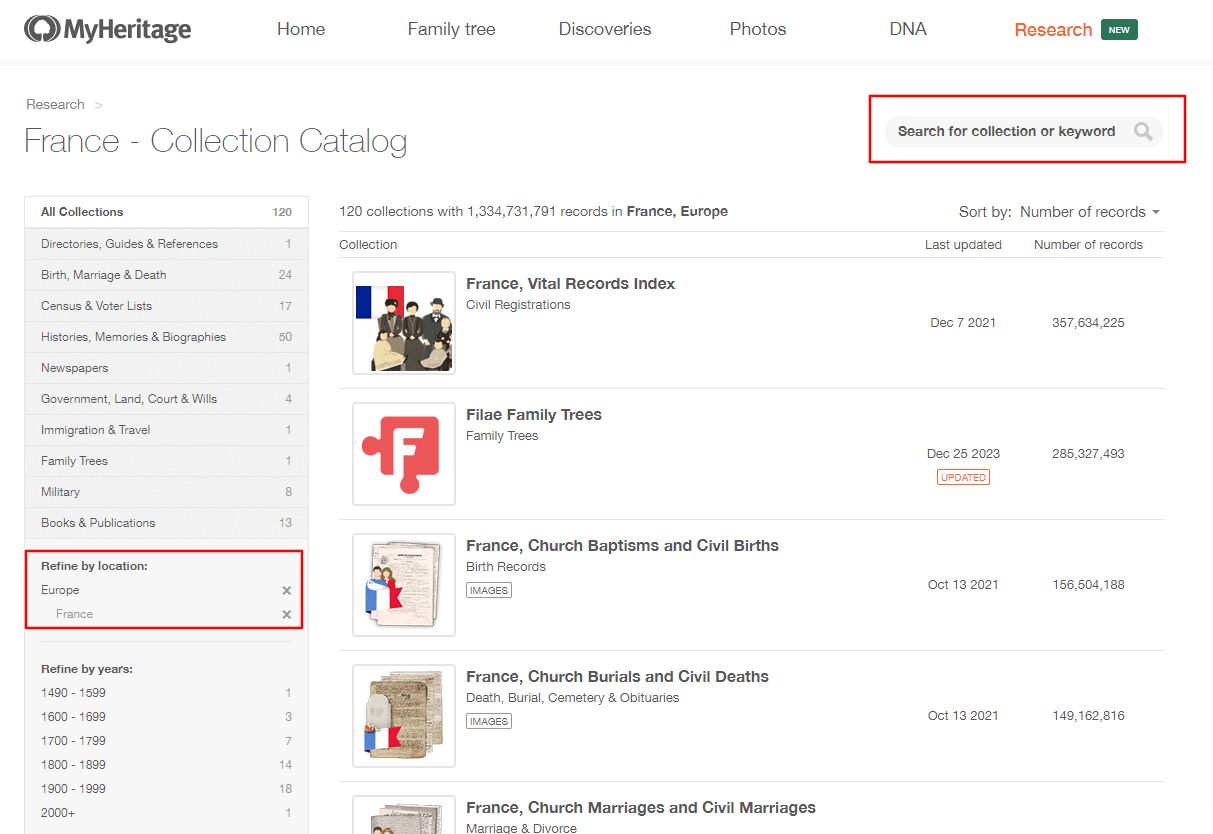
Church and civil vital records in France
Prior to September 1792, records were collected by priests, primarily Catholic priests in local parishes. In September 1792, the government established a process of collecting vital records from the entire population. From this point forward, civil records are very robust. If your ancestor was born before 1792, try looking for a death record — it may contain information on their birth as well.
Births, deaths, and marriages were recorded in the same files, so you may sometimes find a different type of record below or above the one you are viewing. To keep things organized, MyHeritage’s index has these records listed separately:
- France, Church Baptisms and Civil Births
- France, Church Marriages and Civil Marriages
- France, Church Burials and Civil Deaths
Let’s take a look at a couple of examples.
Sample birth record
This record documents the birth of Julia Marie Martin:
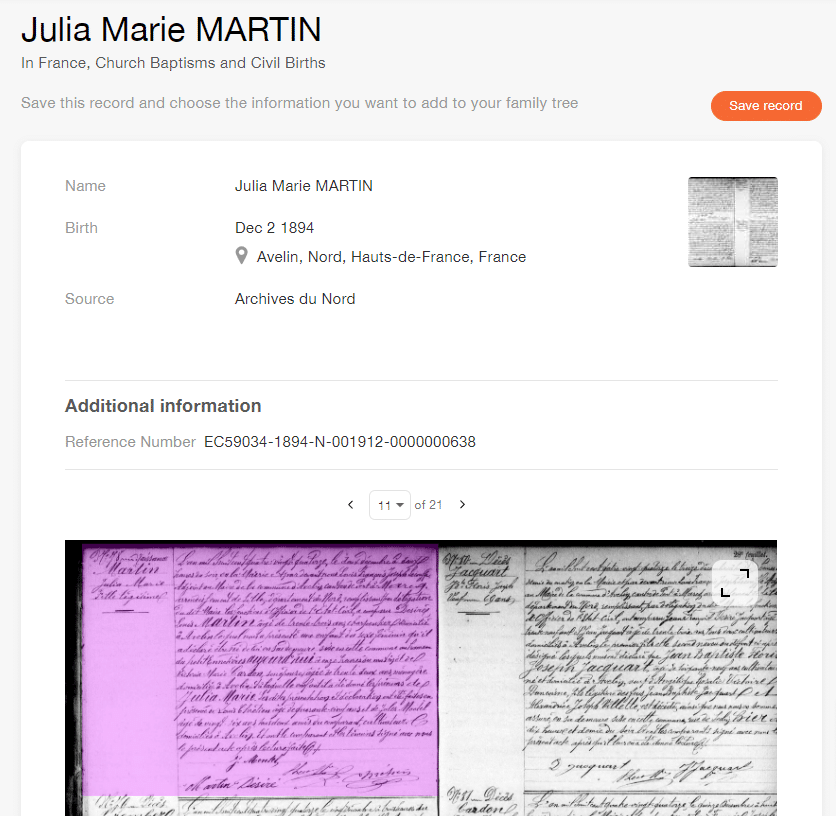
The index lists Julia’s name and the place and date of the record, but the original record contains such a wealth of additional information, it’s worth the effort of learning how to read it.
The record below has some of the basic facts highlighted in different colors — blue for dates and ages, green for names, purple for professions, and orange for places.
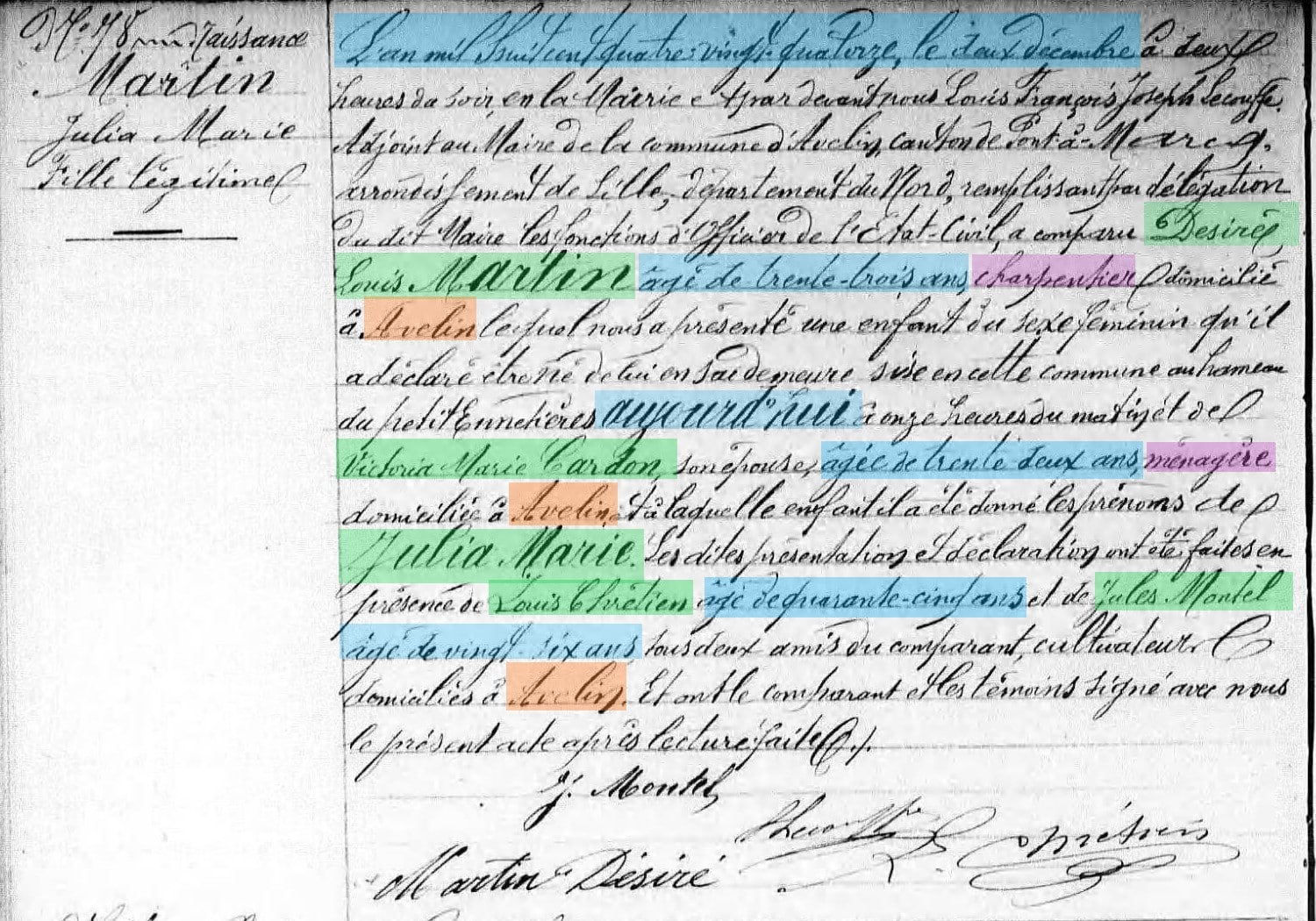
The record lists not only the date (“En mil huit cent quatre-vingt quatorze le deux Decembre”/“In 1894 on the second of December”) but also the time of day the record was made (“a deux heurs de soir”/”At two in the afternoon”). It also specifies when the birth took place: aujourd’hui, meaning “today,” at onze heurs de matin, “11 o’clock in the morning.” In this case, the record was made on the day of the birth, but sometimes, births would be reported a day or two after the event, and the record will say so: hier (yesterday) or avant-hier (the day before yesterday). In these cases, you will be able to obtain a more exact birth date by examining the record.
This record also mentions many other people: the father, Desiree Louis Martin, who declared the birth; the mother, Victoria Marie Cardon; and two witnesses, who, the record specifies, are “deux amis,” “two friends.”
You will also find signatures of the declarer and the witnesses at the bottom of the record.
Sample marriage record
Here’s an example of a marriage record from the France, Church Marriages and Civil Marriages collection:
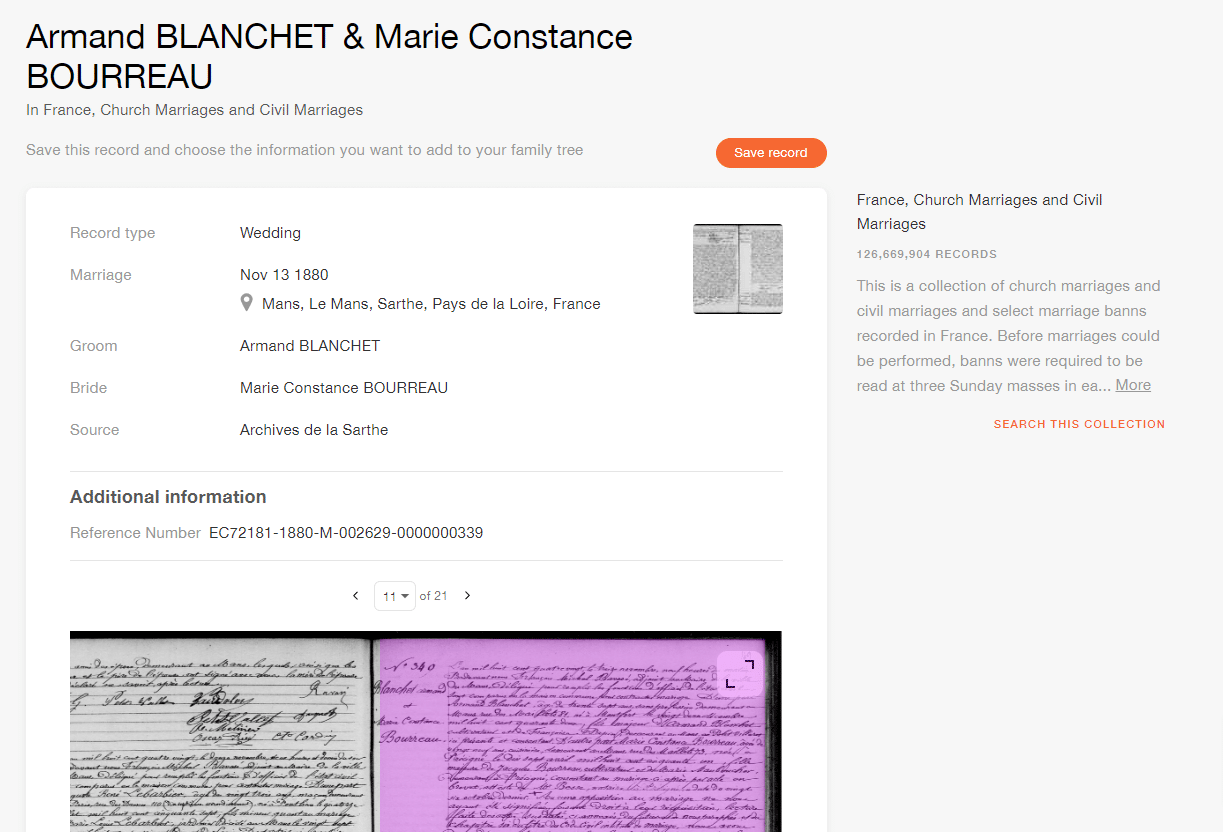
The index lists the date and place of marriage and the names of the bride and groom, but again, a wealth of additional details can be found within the original record. Once again, dates and ages are in blue, names are in green, places are in yellow, occupations are in purple, and relationships are in red:
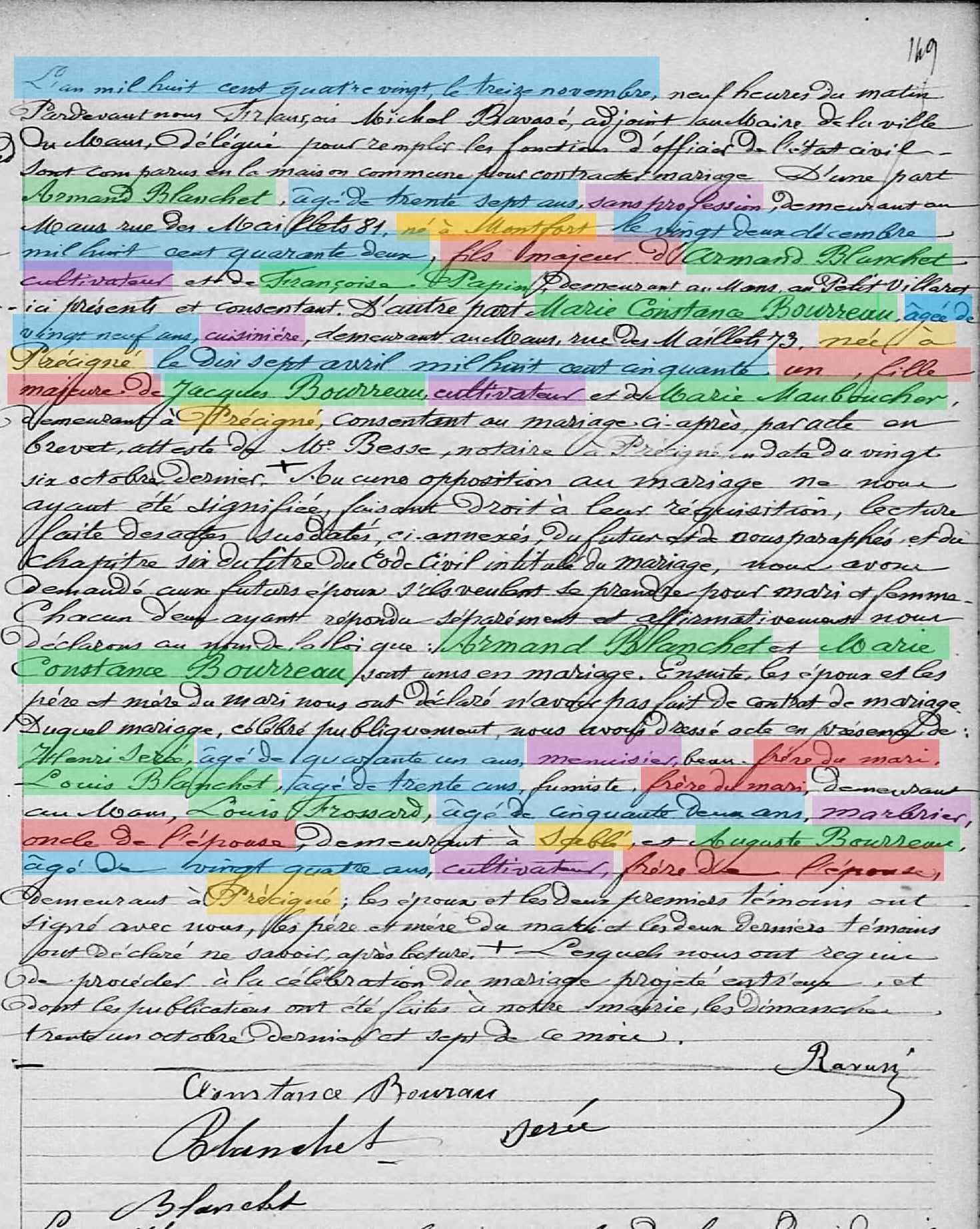
A review of the original scan gives us:
- The ages and dates of birth of the bride and groom
- The places of birth and current addresses of the bride and groom
- The professions of the bride and groom
- The names of each of the parents of the bride and groom, their places of residence, and their professions
- Names, ages, residences, and professions of witnesses, and their relationships to the bride and groom
So for example, in the record above, we learn that the groom, Armand Blanchet, was 37 years old and unemployed (“sans profession”), lived at Rue des Maillets 81, and was born in Montfort on December 22, 1842; and the bride, Marie Constance Bourreau, was 29, worked as a cook, lived at Rue de Maillets 73, and was born in Précigné on April 17, 1850. Armand’s father, also named Armand Blanchet, was a farmer; his mother’s name was Françoise Papin, and they lived in Mans. Marie’s father, Jacques Bourreau, was also a farmer, and he and her mother Marie Mauboucher lived in Précigné.
We also learn that the witnesses included:
- Armand’s brother-in-law J. Henri Serco(?), age 41, a carpenter from Mans
- Armand’s brother, Louis Blanchet, age 30, a chimney sweep from Mans
- Marie’s uncle Louis Frossard, age 52, a stonemason from Sable
- Marie’s brother, Auguste Bourreau, age 28, who was a farmer like his father and lived in Précigné.
That’s a lot of additional information!
French census records
From 1836 to 1936, national censuses were conducted in France every 5 years, except for 1871 and 1916. The 1871 census was delayed until 1872 due to the collapse of the Second French Empire during the Franco-Prussian War, also known as the War of 1870, and the 1916 census was not conducted due to World War I.
Census records are unique in that they provide information about family members living together as well as their relationships, ages, and birth places. The French censuses are not as widely indexed as the vital records are, but that is changing.
One important thing to note about French censuses is that they were not centralized at the national level the way they are in countries such as the United States. Each department of France was responsible for conducting its own census. This means that census records from a particular year may be available from one department, but not another. For example, the 1872 French census available on MyHeritage covers 67 of the 96 departments, and the 1906 census covers 63.
Below is a sample record from the 1872 French census — that of world-famous impressionist painter Claude Monet.
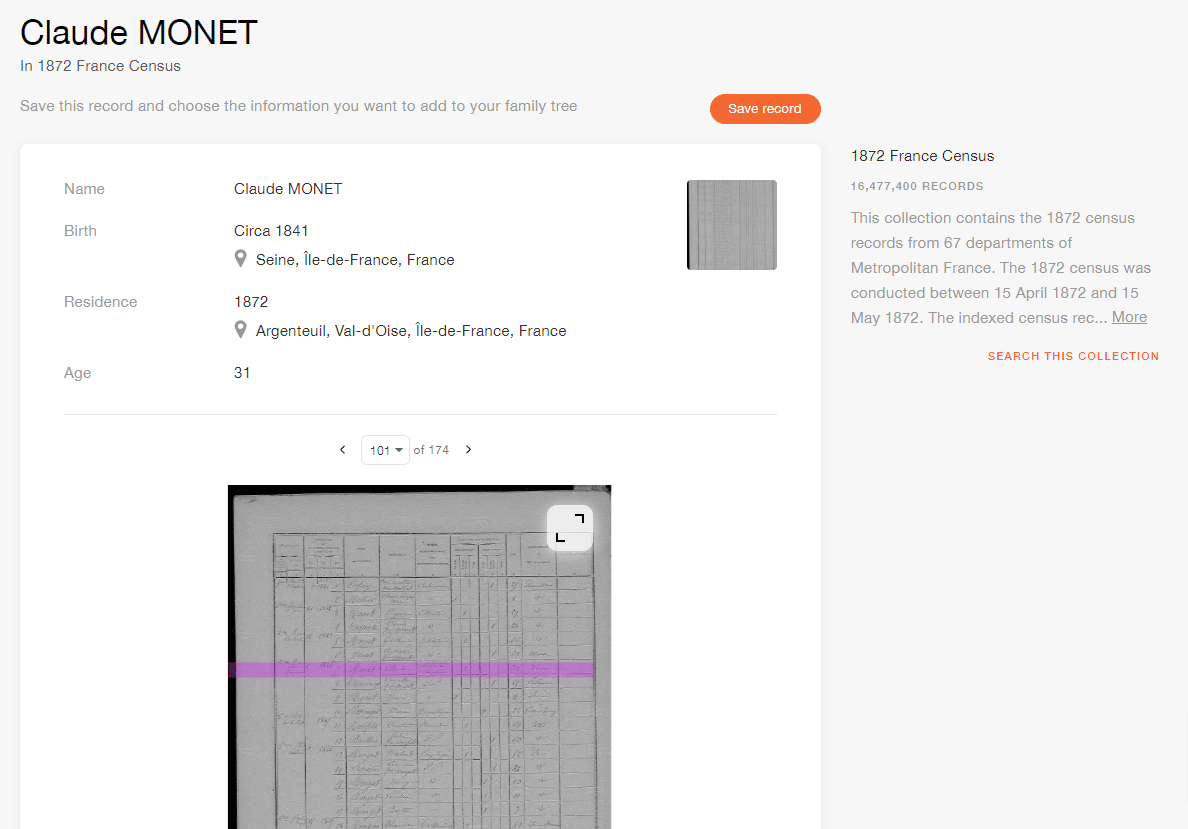
The index includes his name, inferred birth year, place of birth, place of residence, and age. However, once again, taking a closer look at the original scan will provide additional details: for example, his profession as an artist and painter:

Additional records from France
In addition to vital and census records, military records can be of great value. MyHeritage offers a number of important French military record collections:
- France, Military Death Index, 1914-1961
- France, Military Enlistees and Conscripts of Nord
- France, World War II Prisoners of War
- France, Military Conscripts of Seine
- France, Vienne, Military Draft Cards
- France, Calvados, Military Registration Cards
- France, Saône et Loire, Military Conscriptions
- France, Rhône, Military Registration Cards
Another collection of interest is France Newspapers & Periodicals, which contains publications from various cities and towns in France dating from 1644–2000. Newspapers and periodicals contain obituaries, birth, marriage, and death notices, and other important stories that may provide information you won’t find in any other record.
Tips for researching French historical records on MyHeritage
Learn some basic terms in French
As demonstrated above, a rudimentary knowledge of French numbers, family relationships, and other basic terms can greatly enhance what you get out of French historical records. Click here to download a cheat sheet containing common French genealogy terms that you can keep on hand.
Try taking a few classes in basic French, or using a language learning app such a Duolingo (which is free).
Leverage online resources for translation and context
Online French-English dictionaries and automatic translation services can be of enormous help in interpreting historical records.
For more information on specific communes, our Director of Content Mike Mansfield recommends going to the Wikipedia page of the commune in French, which may be much richer than the content available in English. You can do this by clicking the “Languages” button at the top right corner of the page and selecting “Français.” Then, you can Google Translate the full article back into English.
Brush up on your paleography skills
If you’re struggling to read handwritten French records, read our article about deciphering old handwriting to find some useful tips and techniques: Deciphering Old Handwriting: Paleography Strategies & Tips
Stay up to date on new French historical record collections
MyHeritage is constantly adding new historical record collections, and these updates are announced regularly on the MyHeritage Blog, so be sure to follow it. You can also visit the Collection Catalog and sort the collection listing by date of publication to see what’s new.
Check out additional educational resources from MyHeritage on French genealogy
Check out the following resources to learn more about researching French genealogy on MyHeritage and beyond:
- France on the MyHeritage Wiki
- Webinars about French genealogy on Legacy Family Tree Webinars

